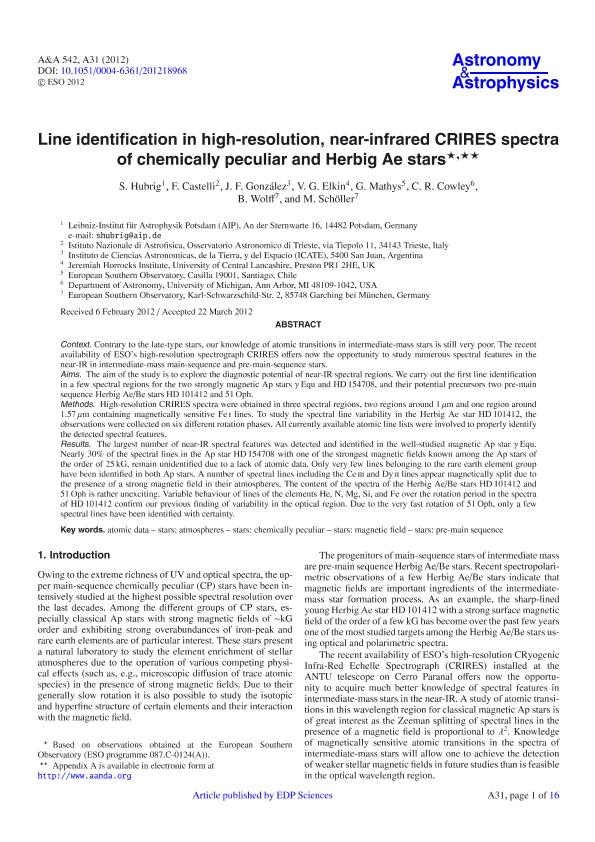Artículo
Line identification in high-resolution, near-infrared CRIRES spectra of chemically peculiar and Herbig Ae stars
Hubrig, S.; Castelli, F.; Gonzalez, Jorge Federico ; Elkin, V. G.; Mathys, G.; Cowley, C. R.; Wolff, B.; Schöller, M.
; Elkin, V. G.; Mathys, G.; Cowley, C. R.; Wolff, B.; Schöller, M.
 ; Elkin, V. G.; Mathys, G.; Cowley, C. R.; Wolff, B.; Schöller, M.
; Elkin, V. G.; Mathys, G.; Cowley, C. R.; Wolff, B.; Schöller, M.
Fecha de publicación:
06/2012
Editorial:
EDP Sciences
Revista:
Astronomy and Astrophysics
ISSN:
0004-6361
Idioma:
Inglés
Tipo de recurso:
Artículo publicado
Clasificación temática:
Resumen
Context. Contrary to the late-type stars, our knowledge of atomic transitions in intermediate-mass stars is still very poor. The recent availability of ESO's high-resolution spectrograph CRIRES offers now the opportunity to study numerous spectral features in the near-IR in intermediate-mass main-sequence and pre-main-sequence stars. Aims. The aim of the study is to explore the diagnostic potential of near-IR spectral regions. We carry out the first line identification in a few spectral regions for the two strongly magnetic Ap stars γ Equ and HD 154708, and their potential precursors two pre-main sequence Herbig Ae/Be stars HD 101412 and 51 Oph. Methods. High-resolution CRIRES spectra were obtained in three spectral regions, two regions around 1 μm and one region around 1.57 μm containing magnetically sensitive Fe i lines. To study the spectral line variability in the Herbig Ae star HD 101412, the observations were collected on six different rotation phases. All currently available atomic line lists were involved to properly identify the detected spectral features. Results. The largest number of near-IR spectral features was detected and identified in the well-studied magnetic Ap star γ Equ. Nearly 30% of the spectral lines in the Ap star HD 154708 with one of the strongest magnetic fields known among the Ap stars of the order of 25 kG, remain unidentified due to a lack of atomic data. Only very few lines belonging to the rare earth element group have been identified in both Ap stars. A number of spectral lines including the Ce iii and Dy ii lines appear magnetically split due to the presence of a strong magnetic field in their atmospheres. The content of the spectra of the Herbig Ae/Be stars HD 101412 and 51 Oph is rather unexciting. Variable behaviour of lines of the elements He, N, Mg, Si, and Fe over the rotation period in the spectra of HD 101412 confirm our previous finding of variability in the optical region. Due to the very fast rotation of 51 Oph, only a few spectral lines have been identified with certainty.
Archivos asociados
Licencia
Identificadores
Colecciones
Articulos(ICATE)
Articulos de INST.D/CS ASTRONOMICAS D/LA TIERRA Y DEL ESPACIO
Articulos de INST.D/CS ASTRONOMICAS D/LA TIERRA Y DEL ESPACIO
Citación
Hubrig, S.; Castelli, F.; Gonzalez, Jorge Federico; Elkin, V. G.; Mathys, G.; et al.; Line identification in high-resolution, near-infrared CRIRES spectra of chemically peculiar and Herbig Ae stars; EDP Sciences; Astronomy and Astrophysics; 542; 6-2012; 1-16; A31
Compartir
Altmétricas



